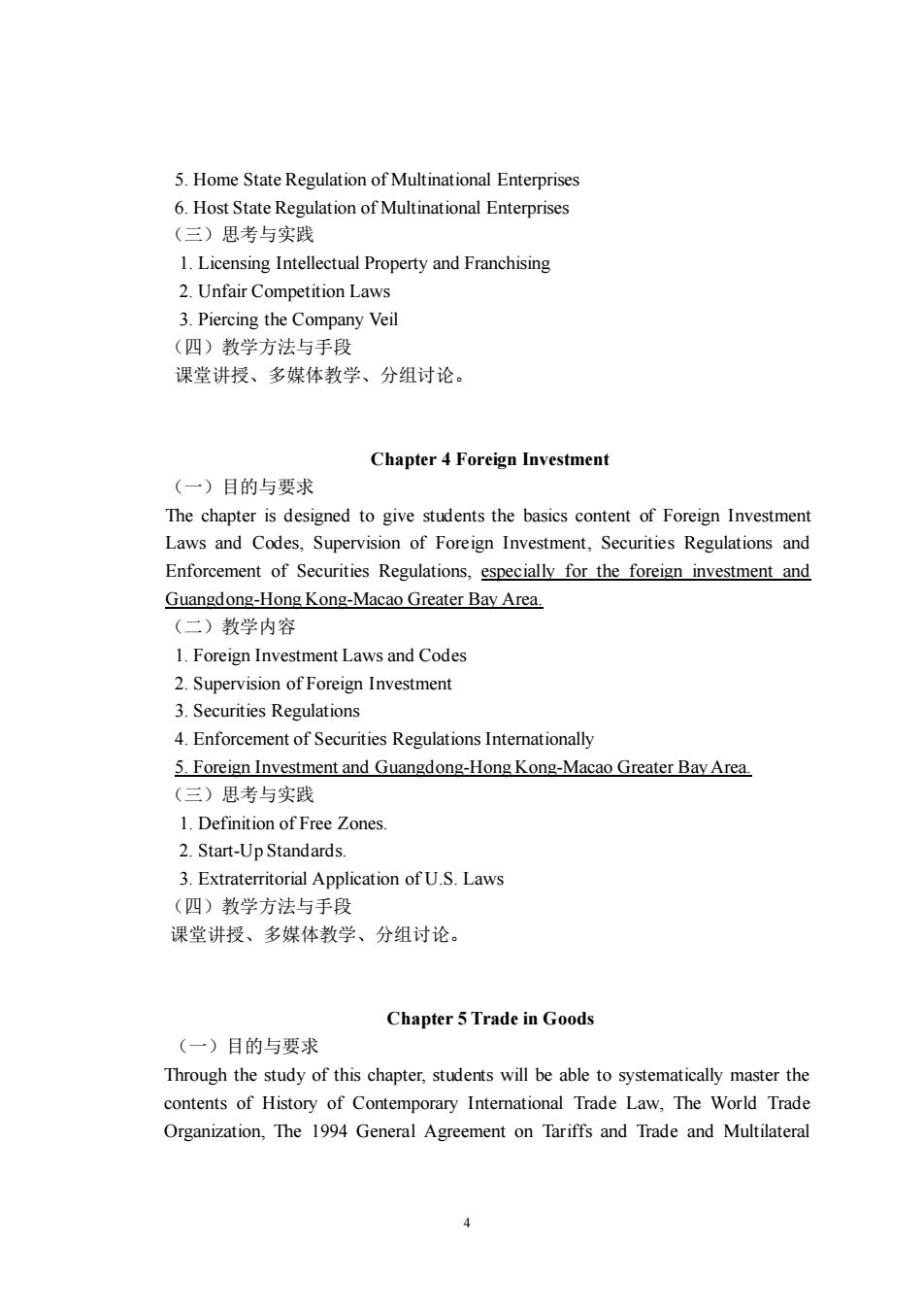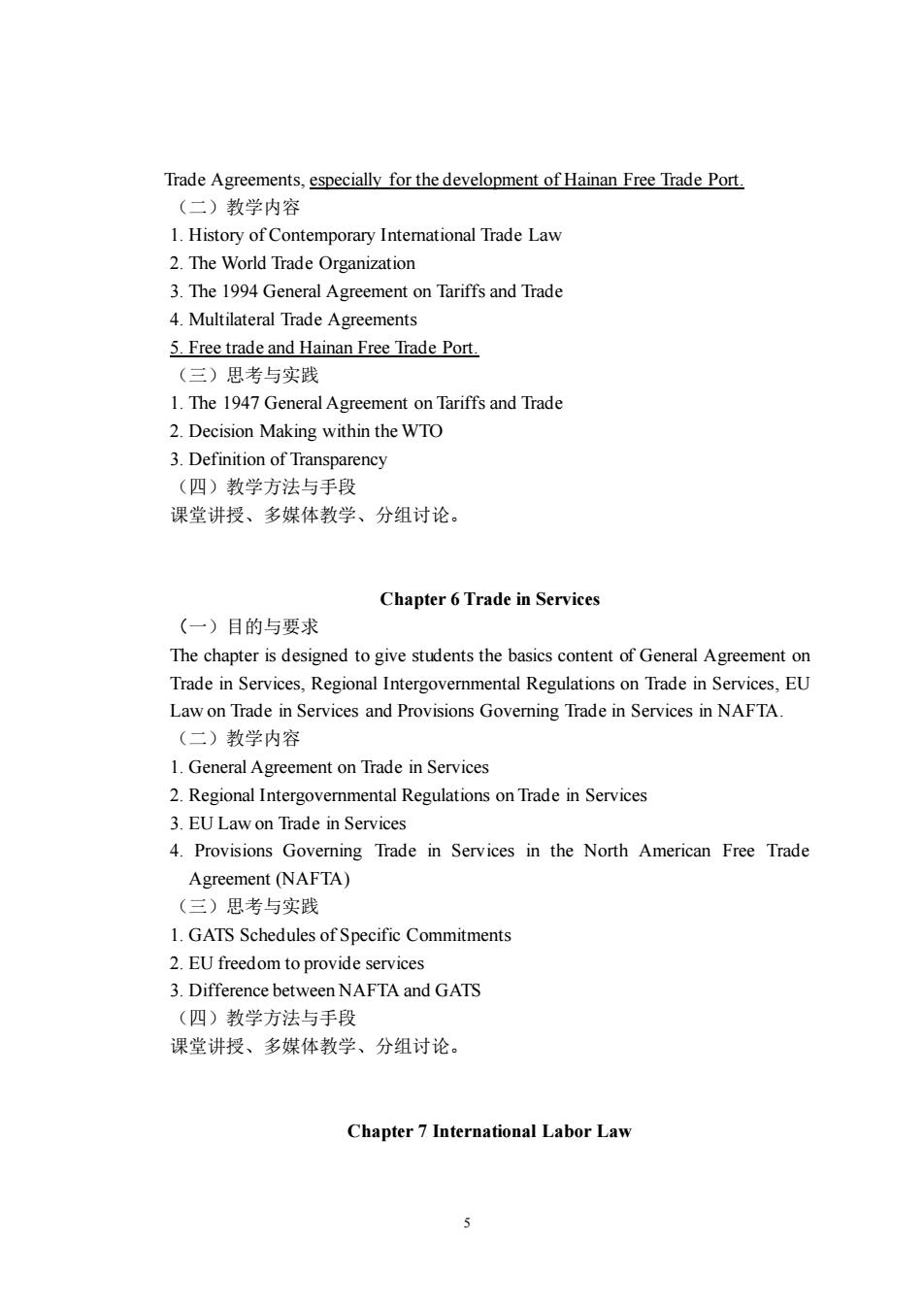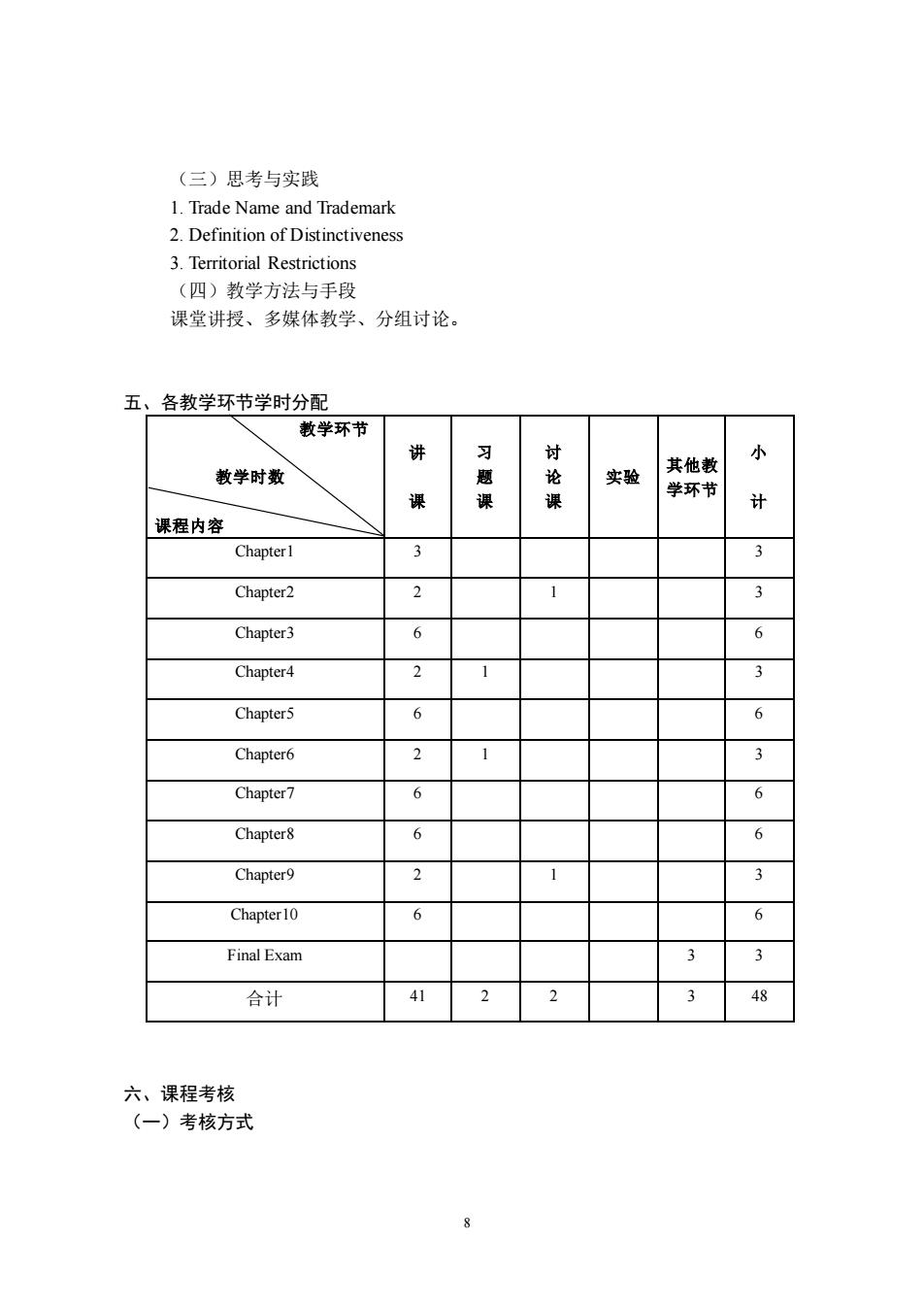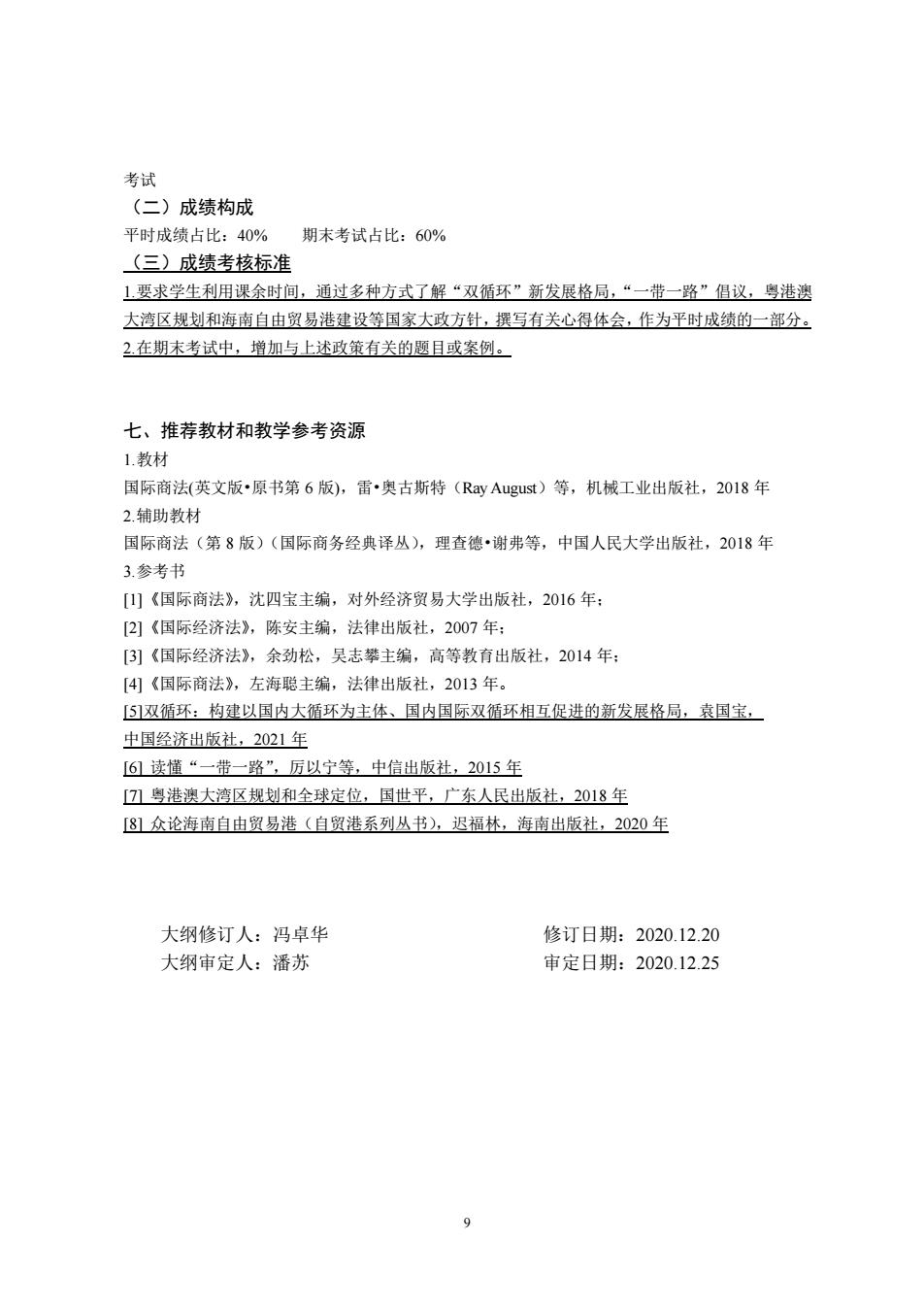
《国际商法与环境》课程教学大纲 一、课程基本信息 课程代码:16236003 课程名称:国际商法与环境 英文名称:International Business Law and Its Environment 课程类别:专业课 学 时:48 分:3 适用对象:国际商务专业、国际商务(实验区)专业 考核方式:考试 先修课程:商法、经济法 二、课程简介 《国际商法及环境》主要讲授与国际商事活动有关的法律规范,是国际商务专业 的核心课程,兼具理论性与实务性。本课程旨在通过理论和经典案例的系统讲授,让 学生了解国际商法的基本内容,培养学生在实践中运用国际商法知识的能力。本课程 的主要内容包括:国际法与比较法,争议解决机制,跨国公司法,外商投资法,货物 贸易法,服务贸易法和国际知识产权法。 International Business Law and its Environment mainly deals with the legal norms related to interational business activities.It is a main course of international business major,which is both theoretical and practical.The course aims to teach students the basic contents of intemational business law through the systematic theories and typical cases,and to cultivate their ability to use the knowledge of international business law in practice.The main contents of the course include:Introduction to Intemational and Comparative Law Dispute Settlement,The Multinational Enterprise,Foreign Investment,Trade in Goods, Trade in Services,Intemational Intellectual Property law 三、课程性质与教学目的 结合国际商法的基础理论和经典案例,重点阐释国内国际“双循环”新发展格局! “一带一路”倡议,粤港澳大湾区规划和海南自由贸易港建设等国家的大政方针,让
1 《国际商法与环境》课程教学大纲 一、课程基本信息 课程代码:16236003 课程名称:国际商法与环境 英文名称:International Business Law and Its Environment 课程类别:专业课 学 时:48 学 分:3 适用对象: 国际商务专业、国际商务(实验区)专业 考核方式:考试 先修课程:商法、经济法 二、课程简介 《国际商法及环境》主要讲授与国际商事活动有关的法律规范,是国际商务专业 的核心课程,兼具理论性与实务性。本课程旨在通过理论和经典案例的系统讲授,让 学生了解国际商法的基本内容,培养学生在实践中运用国际商法知识的能力。本课程 的主要内容包括:国际法与比较法,争议解决机制,跨国公司法,外商投资法,货物 贸易法,服务贸易法和国际知识产权法。 International Business Law and its Environment mainly deals with the legal norms related to international business activities. It is a main course of international business major, which is both theoretical and practical. The course aims to teach students the basic contents of international business law through the systematic theories and typical cases, and to cultivate their ability to use the knowledge of international business law in practice. The main contents of the course include: Introduction to International and Comparative Law, Dispute Settlement, The Multinational Enterprise, Foreign Investment, Trade in Goods, Trade in Services, International Intellectual Property law. 三、课程性质与教学目的 结合国际商法的基础理论和经典案例,重点阐释国内国际“双循环”新发展格局, “一带一路”倡议,粤港澳大湾区规划和海南自由贸易港建设等国家的大政方针,让

学生充分了解国家在经贸领域实施的新举措和取得的瞩目成就,增强学生的责任感、 自豪感和使命感:同时让他们系统掌握国际商法的理论知识和从事国际商事活动时应 遵守的基本法律规范,培养学生运用所学理论分析国际商事法律关系的能力,掌握处 理国际商事纠纷的基本方法。 Combining the basic theories and typical cases,the course will focus on our country's major policies of Domestic and international circulations,Belt and Road Initiative,the Guangdong-Hong Kong-Macao Greater Bay Area and Hainan Free Trade Port.the students will fully understand the country's new initiatives and remarkable achievements in the field of business and the sense of students'responsibility,pride and mission will be highlv enhanced:they will also be able to systematically master the theoretical knowledge of intemational business law and the basic legal norms that should be observed when engaging in international business activities,and the students will be trained to use the theoretical knowledge which they have leamned to analyze intemational business legal relations and master the basic methods of handling intemational business disputes. 四、教学内容及要求 Chapter 1 Introduction to International and Comparative Law (一)目的与要求 this chapter will especially focus on our country's policy of Domestic and international circulations.students will be able to systematically master the themes of International Law.Sources of International Law.International Persons.the Rights of Individuals and Comparison of Municipal Legal Systems. (二)教学内容 1.The Making of International Law 2 Sources of International Law 3.Policy of domestic and intemational circulations and Interational Business Law 4 International persons 5.The Rights of Individuals Under International Law 6.Comparison of Municipal Legal Systems (三)思考与实践 1.What Is Intemational Law? 2.The Significance of domestic and international circulations. 3.The Anglo-American Common Law System (四)教学方法与手段
2 学生充分了解国家在经贸领域实施的新举措和取得的瞩目成就,增强学生的责任感、 自豪感和使命感;同时让他们系统掌握国际商法的理论知识和从事国际商事活动时应 遵守的基本法律规范,培养学生运用所学理论分析国际商事法律关系的能力,掌握处 理国际商事纠纷的基本方法。 Combining the basic theories and typical cases, the course will focus on our country’s major policies of Domestic and international circulations, Belt and Road Initiative, the Guangdong-Hong Kong-Macao Greater Bay Area and Hainan Free Trade Port, the students will fully understand the country’s new initiatives and remarkable achievements in the field of business, and the sense of students’ responsibility, pride and mission will be highly enhanced; they will also be able to systematically master the theoretical knowledge of international business law and the basic legal norms that should be observed when engaging in international business activities, and the students will be trained to use the theoretical knowledge which they have learned to analyze international business legal relations and master the basic methods of handling international business disputes. 四、教学内容及要求 Chapter 1 Introduction to International and Comparative Law (一)目的与要求 this chapter will especially focus on our country’s policy of Domestic and international circulations, students will be able to systematically master the themes of International Law, Sources of International Law, International Persons, the Rights of Individuals and Comparison of Municipal Legal Systems. (二)教学内容 1.The Making of International Law 2.Sources of International Law 3. Policy of domestic and international circulations and International Business Law 4.International Persons 5.The Rights of Individuals Under International Law 6. Comparison of Municipal Legal Systems (三)思考与实践 1. What Is International Law? 2. The Significance of domestic and international circulations. 3. The Anglo-American Common Law System. (四)教学方法与手段

课堂讲授、多媒体教学、分组讨论。 Chapter 2 Dispute Settlement (一)目的与要求 The chapter is designed to give students the basics content of Settlement of Disputes through Diplomacy,International Court of Justice,World Trade Organization Dispute Settlement Procedures.International Center for the Settlement of Investment Disputes and other Arbitration Tribunals,especially interpret the international commercial arbitration in the Belt and Road cooperation. (二)教学内容 1 Settlement of Disputes Through Diplomacy 2.Intemational Court of Justice 3.World Trade Organization Dispute Settlement Procedures 4.Interational Center for the Settlement of Investment Dispute 5.International Commercial Arbitration in Belt and Road cooperation (三)思考与实践 1.Definition of Mediation 2.Funetions ofthe ICJ. 3.Optional Clause Jurisdiction (四)教学方法与手段 课堂讲授、多媒体教学、分组讨论。 Chapter 3The Multinational Enterprise (一)目的与要求 Through the study of this chapter,students will be able to systematically master the contents of Strategies for Doing Business Globally,Business Form,Multinational Organization,International Regulation of Multinational Enterprises,Home State Regulation and Host State Regulation. (二)教学内容 1.Strategies for Doing Business Globally 2.The Business Form 3.The Multinational Organization 4.International Regulation of Multinational Enterprises 3
3 课堂讲授、多媒体教学、分组讨论。 Chapter 2 Dispute Settlement (一)目的与要求 The chapter is designed to give students the basics content of Settlement of Disputes through Diplomacy, International Court of Justice, World Trade Organization Dispute Settlement Procedures, International Center for the Settlement of Investment Disputes and other Arbitration Tribunals, especially interpret the international commercial arbitration in the Belt and Road cooperation. (二)教学内容 1.Settlement of Disputes Through Diplomacy 2.International Court of Justice 3.World Trade Organization Dispute Settlement Procedures 4.International Center for the Settlement of Investment Disputes 5.International Commercial Arbitration in Belt and Road cooperation (三)思考与实践 1. Definition of Mediation. 2. Functions of the ICJ. 3. Optional Clause Jurisdiction. (四)教学方法与手段 课堂讲授、多媒体教学、分组讨论。 Chapter 3 The Multinational Enterprise (一)目的与要求 Through the study of this chapter, students will be able to systematically master the contents of Strategies for Doing Business Globally, Business Form, Multinational Organization, International Regulation of Multinational Enterprises, Home State Regulation and Host State Regulation. (二)教学内容 1. Strategies for Doing Business Globally 2. The Business Form 3. The Multinational Organization 4. International Regulation of Multinational Enterprises

5.Home State Regulation of Multinational Enterprises 6.Host State Regulation of Multinational Enterprises (三)思考与实践 1.Licensing Intellectual Property and Franchising 2.Unfair Competition Laws 3.Piercing the Company Veil (四)教学方法与手段 课堂讲授、多媒体教学、分组讨论。 Chapter 4 Foreign Investment (一)目的与要求 The chapter is designed to give students the basics content of Foreign Investmen Laws and Codes,Supervision of Foreign Investment,Securities Regulations and Enforcement of Securities Regulations.especially for the foreign investment and Guangdong-Hong kong-Macao greater bay area (二)教学内容 1.Foreign Investment Laws and Codes 2.Supervision of Foreign Investment 3.Securities Regulations 4.Enforcement of Securities Regulations Interationally 5.Foreign Investment and Guangdong-Hong Kong-Macao Greater Bav Area (三)思考与实践 1 Definition of Free Zones 2.Start-Up Standards. 3.Extraterritorial Application of U.S.Laws (四)教学方法与手段 课堂讲授、多媒体教学、分组讨论。 Chapter 5Trade in Goods (一)目的与要求 Through the study of this chapter,students will be able to systematically master the contents of History of Contemporary Intemational Trade Law,The World Trade Organization,The 1994 General Agreement on Tariffs and Trade and Multilateral 4
4 5. Home State Regulation of Multinational Enterprises 6. Host State Regulation of Multinational Enterprises (三)思考与实践 1. Licensing Intellectual Property and Franchising 2. Unfair Competition Laws 3. Piercing the Company Veil (四)教学方法与手段 课堂讲授、多媒体教学、分组讨论。 Chapter 4 Foreign Investment (一)目的与要求 The chapter is designed to give students the basics content of Foreign Investment Laws and Codes, Supervision of Foreign Investment, Securities Regulations and Enforcement of Securities Regulations, especially for the foreign investment and Guangdong-Hong Kong-Macao Greater Bay Area. (二)教学内容 1. Foreign Investment Laws and Codes 2. Supervision of Foreign Investment 3. Securities Regulations 4. Enforcement of Securities Regulations Internationally 5. Foreign Investment and Guangdong-Hong Kong-Macao Greater Bay Area. (三)思考与实践 1. Definition of Free Zones. 2. Start-Up Standards. 3. Extraterritorial Application of U.S. Laws (四)教学方法与手段 课堂讲授、多媒体教学、分组讨论。 Chapter 5 Trade in Goods (一)目的与要求 Through the study of this chapter, students will be able to systematically master the contents of History of Contemporary International Trade Law, The World Trade Organization, The 1994 General Agreement on Tariffs and Trade and Multilateral

Trade Agreements,especially for the development of Hainan Free Trade Port. (二)教学内容 1.History of Contemporary Intemational Trade Law 2.The World Trade Organization 3.The 1994 General Agreement on Tariffs and Trade 4.Multilateral Trade Agreements 5.Free trade and Hainan Free Trade Port. (三)思考与实践 1.The 1947 General Agreement on Tariffs and Trade 2.Decision Making within the WTO 3.Definition of Transparency (四)教学方法与手段 课堂讲授、多媒体教学、分组讨论。 Chapter 6 Trade in Services (一)目的与要求 The chapter is designed to give students the basics content of General Agreement on Trade in Services,Regional Intergovemmental Regulations on Trade in Services,EU Law on Trade in Services and Provisions Governing Trade in Services in NAFTA. (二)教学内容 1.General Agreement on Trade in Services 2.Regional Intergovemmental Regulations on Trade in Services 3.EU Law on Trade in Services 4.Provisions Governing Trade in Services in the North American Free Trade Agreement (NAFTA) (三)思考与实践 1.GATS Schedules of Specific Commitments 2.EU freedom to provide services 3.Difference between NAFTA and GATS (四)教学方法与手段 课堂讲授、多媒体教学、分组讨论。 Chapter 7 International Labor Law 5
5 Trade Agreements, especially for the development of Hainan Free Trade Port. (二)教学内容 1. History of Contemporary International Trade Law 2. The World Trade Organization 3. The 1994 General Agreement on Tariffs and Trade 4. Multilateral Trade Agreements 5. Free trade and Hainan Free Trade Port. (三)思考与实践 1. The 1947 General Agreement on Tariffs and Trade 2. Decision Making within the WTO 3. Definition of Transparency (四)教学方法与手段 课堂讲授、多媒体教学、分组讨论。 Chapter 6 Trade in Services (一)目的与要求 The chapter is designed to give students the basics content of General Agreement on Trade in Services, Regional Intergovernmental Regulations on Trade in Services, EU Law on Trade in Services and Provisions Governing Trade in Services in NAFTA. (二)教学内容 1. General Agreement on Trade in Services 2. Regional Intergovernmental Regulations on Trade in Services 3. EU Law on Trade in Services 4. Provisions Governing Trade in Services in the North American Free Trade Agreement (NAFTA) (三)思考与实践 1. GATS Schedules of Specific Commitments 2. EU freedom to provide services 3. Difference between NAFTA and GATS (四)教学方法与手段 课堂讲授、多媒体教学、分组讨论。 Chapter 7 International Labor Law

(一)目的与要求 Through the study of this chapter,students will be able to systematically master the contents of International Labor Organization,Regional Intergovernmental Regulations on Labor,Employment Laws in the EU,Employment Standards of OECD and Movement of Workers (二)教学内容 1.International Labor Organization 2.Regional Intergovernmental Regulations on Labor 3.Employment Laws in the EU 4.Employment Standards of the Organization for Economic Cooperation and Development(OECD) 5.Movement of Workers (三)思考与实践 1.The ILO's institutional structure 2.Settlement of Disputes between ILO Members 3.Regulation of Foreign Workers (四)教学方法与手段 课堂讲授、多媒体教学、分组讨论。 Chapter 8 International copyright law (一)目的与要求 The chapter is designed to give students the basics contents of Definition of Copyright,Pecuniary Rights,Works Covered,Neighboring Rights and Exceptions to Copyright Protection (二)教学内容 1.Definition of Copyright 2.Pecuniary Rights 3.Works Covered 4.Neighboring Rights 5.Exceptions toCopyright Protection (三)思考与实我 1.Definition of Originality 2.Downloading and Copying in Cyberspace 3.Ethical Issue of Copyright
6 (一)目的与要求 Through the study of this chapter, students will be able to systematically master the contents of International Labor Organization, Regional Intergovernmental Regulations on Labor, Employment Laws in the EU, Employment Standards of OECD and Movement of Workers. (二)教学内容 1. International Labor Organization 2. Regional Intergovernmental Regulations on Labor 3. Employment Laws in the EU 4. Employment Standards of the Organization for Economic Cooperation and Development(OECD) 5. Movement of Workers (三)思考与实践 1. The ILO’s institutional structure 2. Settlement of Disputes between ILO Members 3. Regulation of Foreign Workers (四)教学方法与手段 课堂讲授、多媒体教学、分组讨论。 Chapter 8 International copyright law (一)目的与要求 The chapter is designed to give students the basics contents of Definition of Copyright, Pecuniary Rights, Works Covered, Neighboring Rights and Exceptions to Copyright Protection. (二)教学内容 1. Definition of Copyright 2. Pecuniary Rights 3. Works Covered 4. Neighboring Rights 5. Exceptions to Copyright Protection (三)思考与实践 1. Definition of Originality 2. Downloading and Copying in Cyberspace 3. Ethical Issue of Copyright

(四)教学方法与手段 课堂讲授、多媒体教学、分组讨论。 Chapter 9 International patent law (一)目的与要求 Through the study of this chapter,students will be able to systematically master the contents of Definition of Patent,Patents and Other Inventor's Grants,Inventions that Qualify for Patent Protection,Determining Qualifications and Inventions Excluded from Patent Protection. (二)教学内容 1.Definition of Patent 2.Patents and Other Inventor's Grants 3.Inventions That Qualify for Patent Protection 4.Determining Qualifications 5.Inventions Excluded from Patent Protection (三)思考与实践 1.Reasons given to justify the granting of patents 2.Basic kinds of patents 3.Procedures used in reviewing patent applications (四)教学方法与手段 课堂讲授、多媒体教学、分组讨论。 Chapter 10 International Trademark Law (一)目的与要求 The chapter is designed to give students the basics contents of Definition of Trademark.acquiring trademarks.registration criteria refusing registration and Registration Review (二)教学内容 1.Definition of Trademark 2.Acquiring Trademarks 3.Registration Criteria 4.Refusing Registration 5.Registration Review
7 (四)教学方法与手段 课堂讲授、多媒体教学、分组讨论。 Chapter 9 International patent law (一)目的与要求 Through the study of this chapter, students will be able to systematically master the contents of Definition of Patent, Patents and Other Inventor’s Grants, Inventions that Qualify for Patent Protection, Determining Qualifications and Inventions Excluded from Patent Protection. (二)教学内容 1. Definition of Patent 2. Patents and Other Inventor’s Grants 3. Inventions That Qualify for Patent Protection 4. Determining Qualifications 5. Inventions Excluded from Patent Protection (三)思考与实践 1. Reasons given to justify the granting of patents 2. Basic kinds of patents 3. Procedures used in reviewing patent applications (四)教学方法与手段 课堂讲授、多媒体教学、分组讨论。 Chapter 10 International Trademark Law (一)目的与要求 The chapter is designed to give students the basics contents of Definition of Trademark, Acquiring Trademarks, Registration Criteria, Refusing Registration and Registration Review. (二)教学内容 1. Definition of Trademark 2. Acquiring Trademarks 3. Registration Criteria 4. Refusing Registration 5. Registration Review

(三)思考与实践 1.Trade Name and Trademark 2.Definition of Distinctiveness 3.Territorial Restrictions (四)教学方法与手段 课堂讲授、多媒体教学、分组讨论。 五、各教学环节学时分配 学环节 小 教学时数 实验 其他教 课 学环节 计 课程内容 Chapterl Chapter2 Chapter3 6 Chapter4 Chapter5 6 Chapter6 3 Chapter7 Chapter8 6 6 Chapter9 Chapter10 6 Final Exam 3 合计 3 48 六、课程考核 (一)考核方式 8
8 (三)思考与实践 1. Trade Name and Trademark 2. Definition of Distinctiveness 3. Territorial Restrictions (四)教学方法与手段 课堂讲授、多媒体教学、分组讨论。 五、各教学环节学时分配 教学环节 教学时数 课程内容 讲 课 习 题 课 讨 论 课 实验 其他教 学环节 小 计 Chapter1 3 3 Chapter2 2 1 3 Chapter3 6 6 Chapter4 2 1 3 Chapter5 6 6 Chapter6 2 1 3 Chapter7 6 6 Chapter8 6 6 Chapter9 2 1 3 Chapter10 6 6 Final Exam 3 3 合计 41 2 2 3 48 六、课程考核 (一)考核方式

考试 (二)成绩构成 平时成绩占比:40%期末考试占比:60% (三)成绩考核标進 1要求学生利用课余时间,通过多种方式了解“双循环”新发展格局,“一带一路”倡议,粤港澳 大湾区规划和海南自由贸易港建设等国家大改方针,撰写有关心得体会,作为平时成绩的一部分 2.在期末考试中,增加与上述政策有关的颗目或案例。 七、推荐教材和教学参考资源 】教材 国际商法(英文版·原书第6版),雷·奥古斯特(Ray August)等,机械工业出版社,2018年 2.辅助教材 国际商法(第8版)(国际商务经典译丛),理查德·谢弗等,中国人民大学出版社,2018年 3.参考书 [1】《国际商法》,沈四宝主编,对外经济贸易大学出版社,2016年: []《国际经济法》,陈安主编,法律出版社,2007年: [3)《国际经济法》,余劲松,吴志攀主编,高等教育出版社,2014年: [4《国际商法》,左海聪主编,法律出版社,2013年。 双循环:构建以国内大循环为主体、国内国际双循环相互促进的新发展格局,袁国宝, 中国经济出版社,2021年 [6读懂“一带一路”,厉以宁等,中信出版社,2015年 [☑粤港澳大湾区规划和全球定位。国世平,广东人民出版社,2018年 [8众论海南自由贸易港(自贸港系列丛书),迟福林,海南出版社,2020年 大纲修订人:冯卓华 修订日期:2020.12.20 大纲审定人:潘苏 审定日期:2020.12.25 9
9 考试 (二)成绩构成 平时成绩占比:40% 期末考试占比:60% (三)成绩考核标准 1.要求学生利用课余时间,通过多种方式了解“双循环”新发展格局,“一带一路”倡议,粤港澳 大湾区规划和海南自由贸易港建设等国家大政方针,撰写有关心得体会,作为平时成绩的一部分。 2.在期末考试中,增加与上述政策有关的题目或案例。 七、推荐教材和教学参考资源 1.教材 国际商法(英文版•原书第 6 版),雷•奥古斯特(Ray August)等,机械工业出版社,2018 年 2.辅助教材 国际商法(第 8 版)(国际商务经典译丛),理查德•谢弗等,中国人民大学出版社,2018 年 3.参考书 [1]《国际商法》,沈四宝主编,对外经济贸易大学出版社,2016 年; [2]《国际经济法》,陈安主编,法律出版社,2007 年; [3]《国际经济法》,余劲松,吴志攀主编,高等教育出版社,2014 年; [4]《国际商法》,左海聪主编,法律出版社,2013 年。 [5]双循环:构建以国内大循环为主体、国内国际双循环相互促进的新发展格局,袁国宝, 中国经济出版社,2021 年 [6] 读懂“一带一路”,厉以宁等,中信出版社,2015 年 [7] 粤港澳大湾区规划和全球定位,国世平,广东人民出版社,2018 年 [8] 众论海南自由贸易港(自贸港系列丛书),迟福林,海南出版社,2020 年 大纲修订人:冯卓华 修订日期:2020.12.20 大纲审定人:潘苏 审定日期:2020.12.25